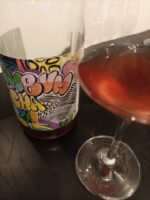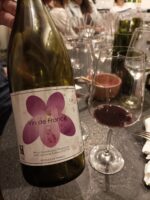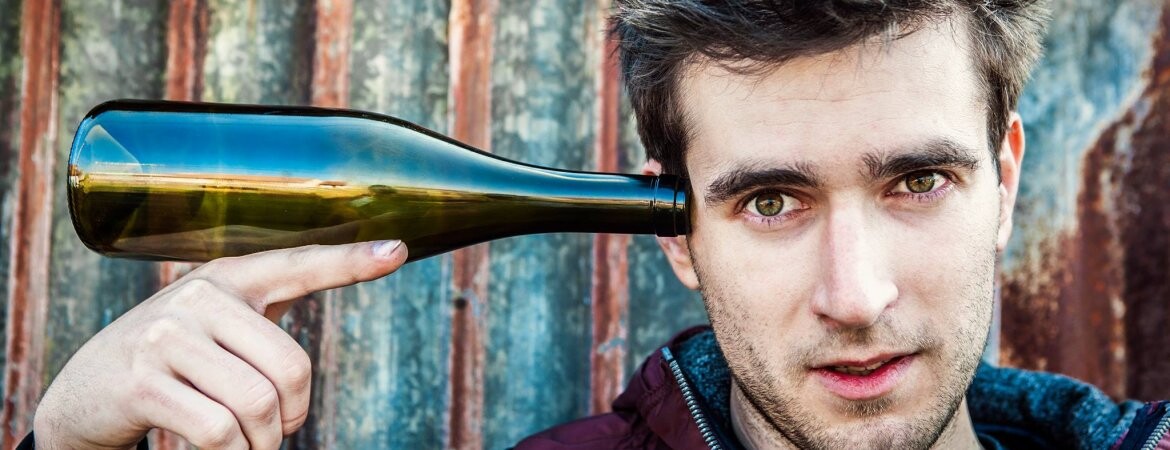Bum Bum Cha !
Last night’s tasting kicked off with a fun and highly creative ‘surprise’ wine. A lovely way to end this November 2021. The bottle had travelled south to us all the way from the Czech Republic, forgive me but I had never associated the former Slavia with vines up until now that is, silly me! This wine had come from just one barrel of pressed Riesling that needed topping up, so they used some of the wine from the barrel of Blaufränkisch sitting next to it down there in the cellar. The result was a delicious Rosé Pet Nat with a wildness, light sparkle and a lot of aromas, raspberry, pomegranate and red currant. A dryish, stony finish. The colorful crazy label was designed by Brazilian artist, Ciro Bicudo and the back label tells us that this wine was ‘unfiltered’ and made with no additional sulphates, 11% of alcohol. Milan Nestarec is the wine-maker there and this was just one of many funky natural juice-wines that he puts together to quench the thirst of our millennial and older funky wine drinking generations. Bum Bum Cha 2020 was a lovely surprise and a great start to the evening.
 What ensued was more serious, still a little funky, and there was not a boring wine amongst them. Domaine Roulot’s 2018 Bourgogne Aligote was pure, layered Aligote, wide with crystaline fruit. Superb!
What ensued was more serious, still a little funky, and there was not a boring wine amongst them. Domaine Roulot’s 2018 Bourgogne Aligote was pure, layered Aligote, wide with crystaline fruit. Superb!
Then my current Chablis needs where fulfilled with Eleni & Edouard Vocoret’s 2019 ‘Le Bas de Chapelot’. An excellent Chablis from grapes picked at the foot of Montee de Tonnerre. A wine very much in the style of a Vincent Dauvissat Chablis, showing discreet and subtle scents of blood orange and apricot blossom. A bitter and slightly buttery finish. Excellent! I read later that Vincent Dauvissat not only mentored Eleni in the art of, but also helped her and Edouard set up the domaine. A very impressive, structured and a full-bodied Chablis.
 Next up where a couple of local big hitters, the 2020 Fosil from the Zuccardi stable and a Jean-Marc Roulot collaboration with Piero Incisa della Rochetta down there in the Rio Nego (Patagonia), and their 2020 Chacra Chardonnay. Both whites, not unsuprisingly, showing some peach and nectarine. Fresh salinity (very fashionable now in Argyland) and a mouth coating ripeness that makes one want to go back for more and more. The only thing stopping me from becoming a Fosil addict is the price.
Next up where a couple of local big hitters, the 2020 Fosil from the Zuccardi stable and a Jean-Marc Roulot collaboration with Piero Incisa della Rochetta down there in the Rio Nego (Patagonia), and their 2020 Chacra Chardonnay. Both whites, not unsuprisingly, showing some peach and nectarine. Fresh salinity (very fashionable now in Argyland) and a mouth coating ripeness that makes one want to go back for more and more. The only thing stopping me from becoming a Fosil addict is the price.
A welcome pause for a large plate of fresh oysters, shipped up from Chubut, before heading into the red territory. First up was Claus Preisinger’s Blaufränkisch from 2020 vintage. Deep deep ruby. Blackcurrant and herbal nose to die for. A palate of red berries served up on a chalky plate. Moorish!
 Then a familiar, to me, Morgon from Marcel Lapierre and his 2018. I would have decanted this one for a breather. But it still came up with the usual exotic spice magic. Boysenberry, fresh flowers and wild raspberry. Sappy, strong and still far too young. I mut have been lucky enough to taste and drink this wine at least 12 times before, and I wish I had really hidden that case away somewhere as the wine needs another 9-10 years to really come round.
Then a familiar, to me, Morgon from Marcel Lapierre and his 2018. I would have decanted this one for a breather. But it still came up with the usual exotic spice magic. Boysenberry, fresh flowers and wild raspberry. Sappy, strong and still far too young. I mut have been lucky enough to taste and drink this wine at least 12 times before, and I wish I had really hidden that case away somewhere as the wine needs another 9-10 years to really come round.
A local red was next. The 2019 Zuccardi Malbec from Sebastian’s Amphora Project. Intense purple, fresh plum and black olive. Chalky, sorry I mean Amphorarym, super concentrated and yet still fresh almost light.
 Back to France with another surprising wine for me. The label simply read Vin de France ‘sans filtration’ by La Grande Colline. Domaine de la Grande Colline you will find in St.Peray. They produce tiny quantities of Cornas and St.Joseph. This bottle of Cornas was the last vintage ever made, 2015, by the then Japanese owner Hirotake Ooka. I did a little probing to find out that Hirotake began studying Chemistry and Biology at home in Japan, but decided midway though his studies that he wanted to make wine and left to study oenology in Bordeaux. While at school he became enamored with the wines of the Northern Rhone and upon graduation approached Thierry Allemand for a position, but none were available. He ended up working with winemaker Jean-Louis Grippat and when Grippat’s vines were acquired by Guigal, Hirotake worked his way up to Chief of Vineryard Management for Hermitage and St. Joseph vines for all of the Grippat and Vallouit estates. At this time he was also spending his weekends working with Allemand, and was becoming more and more convinced that wine should be made without additives. When a position opened in the early 2000’s with Allemand, Hirotake left Guigal and at the same time he purchased a few vines and a winery in the town of St. Peray. His first vintage was in 2001 from vineyards that were not worked at all and that had absolutely no vine treatments, not even ones allowed in organic viticulture. Hirotake prefers to let the vines grown on their own, totally undisturbed.
Back to France with another surprising wine for me. The label simply read Vin de France ‘sans filtration’ by La Grande Colline. Domaine de la Grande Colline you will find in St.Peray. They produce tiny quantities of Cornas and St.Joseph. This bottle of Cornas was the last vintage ever made, 2015, by the then Japanese owner Hirotake Ooka. I did a little probing to find out that Hirotake began studying Chemistry and Biology at home in Japan, but decided midway though his studies that he wanted to make wine and left to study oenology in Bordeaux. While at school he became enamored with the wines of the Northern Rhone and upon graduation approached Thierry Allemand for a position, but none were available. He ended up working with winemaker Jean-Louis Grippat and when Grippat’s vines were acquired by Guigal, Hirotake worked his way up to Chief of Vineryard Management for Hermitage and St. Joseph vines for all of the Grippat and Vallouit estates. At this time he was also spending his weekends working with Allemand, and was becoming more and more convinced that wine should be made without additives. When a position opened in the early 2000’s with Allemand, Hirotake left Guigal and at the same time he purchased a few vines and a winery in the town of St. Peray. His first vintage was in 2001 from vineyards that were not worked at all and that had absolutely no vine treatments, not even ones allowed in organic viticulture. Hirotake prefers to let the vines grown on their own, totally undisturbed.
His winery is equally magical, with his wine cellar-cave carved into the side of a mountain providing a humidity with intensity. Some barrels even have mushrooms growing on them and Hirotake considers this environment to be an advantage! These natural elements are all part of the terroir of the cellar and an essential part of his wine. Hirotake planted the vineyard 100% Syrah on the steep hills of Cornas, bringing his total estate to 3.8 hectares. He returned to his native Japan after the 2015 vintage, his last one. With more time in the glass, this wine seriously opened up and got away from hints of soya sauce and smoke to offer up salty olive, cracked pepper and dark floral tones. Dense blackberry and a soft tannic background. Surprising! in a good way.
 Plates of rare beef where served along with the last red of the evening. A classic! and probably the most unsuprising red wine in the world today, as it is just so reliable and affordable. Has anyone ever had a bad bottle of R.Lopez de Heredia’s Vina Tondonia Reserva, in this case the 2008 vintage. Dried cherry, cigar box, rose-spice. Lively and long, dried tobacco harvest and vanillary smooth finish. I have one magnum of 2004 in the cellar here and I now know what I will be enjoying over Christmas lunch this year.
Plates of rare beef where served along with the last red of the evening. A classic! and probably the most unsuprising red wine in the world today, as it is just so reliable and affordable. Has anyone ever had a bad bottle of R.Lopez de Heredia’s Vina Tondonia Reserva, in this case the 2008 vintage. Dried cherry, cigar box, rose-spice. Lively and long, dried tobacco harvest and vanillary smooth finish. I have one magnum of 2004 in the cellar here and I now know what I will be enjoying over Christmas lunch this year.
This and that!
Thank you dear reader for getting this far. If you do follow any of our monthly bloggeries then you will understand that I must send a huge, huge note of thanks to those lovely folks over in Chablis. Someone read my plea last month, ‘Wot no Chablis’ and past it on to William Fevre. Last week there was a knock on the door here and Fedex handed over a parcel containing 2 bottles of Chablis Villages Domaine William Fevre. One from 2016 and the other from 2018 vintage and both from the greatest domaine in Chablis, Domaine William Fevre. Having let the bottles rest for over a week I just had to get stuck in. And with gusto I did just that. 2018 Chablis had a lively green apple and crushed limestone feel to it. Crisp acidity and a wide girth. The 2016 Chablis shouted lemon, mango and lichee. An acidic limeness that I adore. Needless to say the bottle evaporated in front of my own eyes rather too quickly.
Merci beaucoup Domaine William Fevre!
When was the last time you actually heard someone whistling freely in the street? Well if you had been in my neighbourhood last week you would have done so. It was me! Those two Chablis Villages and the generosity of the senders really put me in a good mood. There is still life after WW3 after all.
Until the next…….

“Just whistle while you work, and cheerfully together we can tidy up the place, so hum a merry tune, it won’t take long when there’s a song to help you set the pace. And as you sweep the room, imagine that the broom is someone that you love, and soon you’ll find you’re dancing to the tune, when hearts are high the time will fly, so whistle while you work”